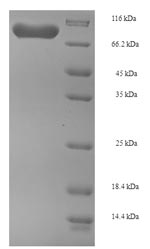This Human PGM1 recombinant protein was produced in E. coli, where the gene sequence encoding Human PGM1 (1-562aa) was expressed with the N-terminal 6xHis-SUMO tag. The purity of this PGM1 protein was greater than 90% by SDS-PAGE.
PGM1 is an enzyme with the primary function of catalyzing the interconversion of glucose-6-phosphate (G6P) and glucose-1-phosphate (G1P) in the sugar metabolism pathway. Specifically, it converts G6P to G1P or G1P to G6P. This enzymatic activity is crucial for cellular energy metabolism and the synthesis and breakdown of sugars. PGM1 is involved in multiple sugar metabolism pathways, including sugar isomerization, sugar alcohol phosphorylation, and glycogen synthesis and breakdown. These pathways are essential for maintaining cellular energy balance and survival.
The PGM1 gene is located in the human genome, and mutations or genetic variations can lead to a rare inherited metabolic disorder known as PGM1 deficiency disease (PGM1-CDG). This is a glycoprotein glycosylation disorder, and patients typically exhibit multisystem symptoms, including growth retardation, neurological issues, and immune system problems.






